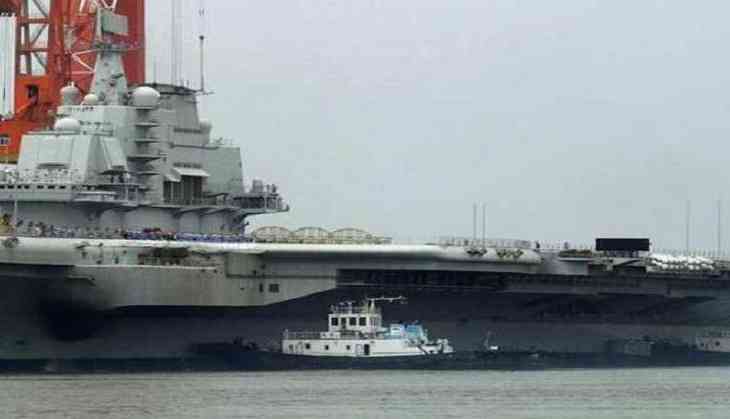
As China prepares to imminently launch its first indigenously built aircraft carrier in Dalian, and as the People's Liberation Army Navy (PLAN) celebrated its 68th anniversary on 23 April, attention is turning to how and where China will use its growing fleet of such platforms.
The mention of Pakistan as a possible base for the PLAN raises the growing specter of Chinese warships crisscrossing and patrolling the Indian Ocean even more than it has hitherto. This is, and should be, of concern to India, even though Beijing is legally entitled to do so.
David Shinn, an adjunct professor at the Elliott School of International Affairs at George Washington Universityand writing for The Jamestown Foundation, commented, "Since 2008, China has significantly increased its naval presence in the Indian Ocean, giving rise to Indian concerns of potential military encirclement and raising questions in American strategic thinking about China's ultimate objectives. Both the United States and India maintain a much stronger naval presence than China in the Indian Ocean, but the balance is beginning to shift."
The PLAN's very first foray into the western Indian Ocean was only in 2000, but the PLAN has since gained far more than just a temporary foothold in the western Indian Ocean. This opportunity was leveraged by China in December 2008 when it deployed its first anti-piracy task force to the Gulf of Aden.
The 25th rotational anti-piracy task force is now operating there, with a typical group comprising two warships and a replenishment vessel. However, in 2014 the PLAN also dispatched a conventional submarine and a nuclear-powered submarine the following year. Given that submarines are not ideal platforms with which to intercept pirates, there were obviously deeper strategic reasons behind it, including giving the PLAN invaluable deployment experience.
Furthermore, for the past five years there were no pirate attacks by Somalia-based pirates, but there has been a resurgence since March. For example, earlier this monthIndian Navy (IN) warships and a PLAN warship helped rescue the Tuvalu-flagged bulk carrier OS 35 after being boarded by pirates.
Interestingly, despite zero pirate attacks for many months, China has not brooked the idea of removing its naval presence in the area. In fact, it is quite the reverse. Since last year China has been constructing a so-called "logistics facility" in Djibouti under a ten-year leasing agreement.
There is absolutely no chance that China will withdrawfrom the Gulf of Aden or Djibouti, no matter what the piracy threat is. This can be traced back to several reasons. One is China's growing international interests and investments in places like Africa and the Middle East. The presence of forward-deployed military assets helps protect Chinese citizens and businesses.Evacuations by PLAN warships have already occurred in Yemen and Libya, for instance.
Another is President Xi Jinping's hallmark One Belt, One Road (OBOR) initiative. This strategic "21st Century Maritime Silk Road" stretches from the Chinese coast, through the Indian Ocean, reaching the African coast and even as far as the eastern Mediterranean. Military engagement will closely follow economic investment along these various tentacles that this initiative is spreading.
China, often dubbed "the factory of the world" and operating the fourth largest commercial shipping fleet in the world, is totally reliant on seaborne trade for raw materials and exports. It is the largest consumer of imported oil, of which 52% comes from the Middle East and 22% from Africa. Thus, 82% of its oil transits the Strait of Malacca chokepoint, and nearly 40% through the Strait of Hormuz.
Such figures underscore the necessity of China protecting its sea lines of communication. This is also why China is showing interest in the Arctic northern sea route.
Another reason is China's contribution to United Nations peacekeeping missions, including 235 personnel in Darfur in Sudan and 1,063 soldiers in South Sudan at the moment. If it has military outposts along the periphery of the Indian Ocean, including Africa, China could rapidlysupport these UN deployments.
China has not been totally coy about its expanded security remit either. Its 2015 Defense White Paper promised the country would protect interests "concerning energy and resources, strategic sea lines of communications, as well as institutions, personnel and assets abroad". Consequently, the PLA is required to"safeguard the security of China's overseas interests" and build the nation "into a maritime power."
Establishing overseas bases or support facilities is also in natural accord with China's declared policy of shifting to a combination of "offshore waters defense" and "open seas protection".
The revelation that the PLAN Marine Corps will multiply from its present 20,000 members to nearly 100,000 is again further indication that China is seriously eyeing and anticipating overseas expeditionary deployments. Some will doubtlessly deploy to Djibouti, and Gwadar is another expected destination.
China's single carrier, the Liaoning, has not ventured farther afield than the South China Sea, but it is only a matter of time before a Chinese carrier does enter the Indian Ocean.
Where else could China set up military bases? Apart from the aforementioned Gwadar port and Djibouti base, Chinese corporations have been building commercial port facilities in Egypt (at both ends of the Suez Canal), Myanmar, Sri Lanka and Tanzania. The Seychelles and Maldives have previously been named in mostly Indian publications as potential hosts for Chinese bases, but no such deal has eventuated to date.
Incidentally, in 2011 China won a 15-year contract from the International Seabed Authority to prospect the seabed in a zone south of Madagascar, and a Chinese research vessel has been operating there since 2015.
Amidst a fair degree of Indian paranoia over the "string of pearls" issue, it is important to remember that China's highest priority remains its own coast, the South China Sea, Strait of Malacca and Western Pacific.
China is particularly wary of the Malacca Straitchokepoint, which is just two miles wide at its narrowest point. Former president Hu Jintao labeled it the Malacca Dilemma, and this is a major reason why China has been building overland oil and gas pipelines to reduce dependence on this vulnerable strait, including the China-Pakistan Economic Corridor.
China has invested heavily to create military infrastructure on reclaimed reefs in the South China Sea. Not only do these bases protect Hainan Island, home to a PLAN nuclear submarine base, but they help shore up the eastern end of the Malacca Strait. It is only natural that China will try to do the same in places like Djibouti and along the Indian Ocean rim, even though it must tread softly because of the political sensitivity of the issue.
-ANI







![BJP's Kapil Mishra recreates Shankar Mahadevan’s ‘Breathless’ song to highlight Delhi pollution [WATCH] BJP's Kapil Mishra recreates Shankar Mahadevan’s ‘Breathless’ song to highlight Delhi pollution [WATCH]](http://images.catchnews.com/upload/2022/11/03/kapil-mishra_240884_300x172.png)

![Anupam Kher shares pictures of his toned body on 67th birthday [MUST SEE] Anupam Kher shares pictures of his toned body on 67th birthday [MUST SEE]](http://images.catchnews.com/upload/2022/03/07/Anupam_kher_231145_300x172.jpg)






